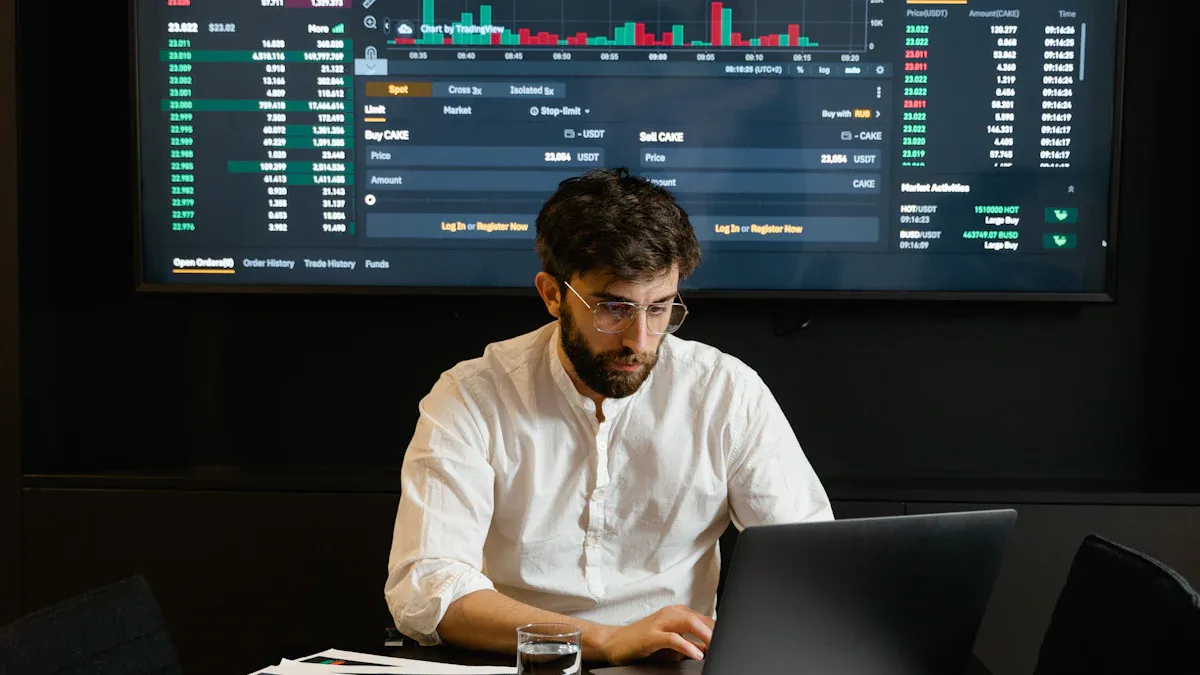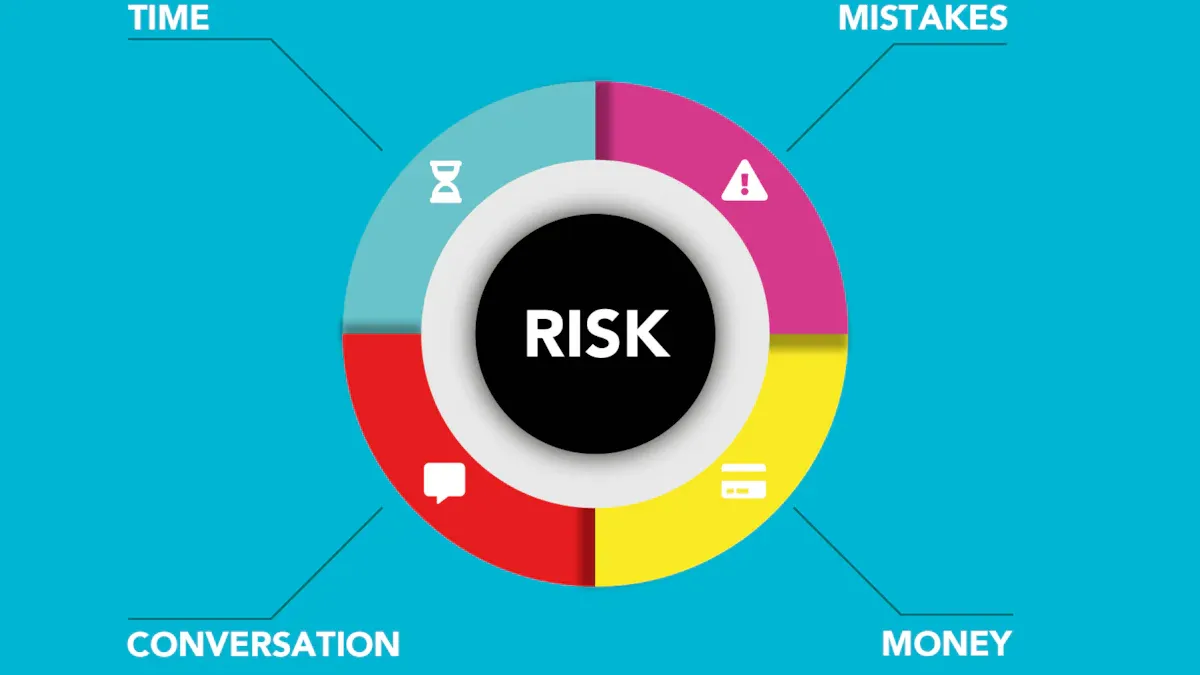Mitigating Economic Risks in Micromarkets for Sustainable Success

How can businesses keep safe from Economic Risks in micromarkets and still try for long-term success? Operators find special ways to make money. They see more sales because people snack more. For example, sales of salted snacks, bars, and mixes went up by 27%. Many operators say they make more than 10% profit. These numbers go up every year. Companies save money by using smaller spaces. They also do not need cashiers. They use AI and data analytics to help with inventory. These tools also help them make better promotions. Local risks are tough for every operator. These risks include too many businesses, not enough workers, and theft. Smart plans help businesses stay strong in changing markets.
Key Takeaways
Micromarkets do well by knowing what customers like. Operators should watch what people buy. This helps them pick the best products and waste less.
Diversification helps manage risks. Put money into different products and suppliers. This protects you from losing too much.
Technology helps operators stay ahead. Tools like AI and data analytics help manage inventory. They also make customer experiences better.
Checking performance metrics often is important. Watch sales, shrinkage rates, and customer feedback. This helps find problems early.
Being able to change is important for success. Operators must be ready to change plans. This helps when the market changes or new risks come up.
Understanding Micromarkets and Economic Risks
Defining Micromarkets
A micromarket is a small store. It sells snacks, drinks, and other things. These stores are in offices, hotels, and apartments. Operators use technology to track what is sold. Shoppers do not need cashiers. They scan what they want and pay at a kiosk or on an app. This way saves time and money for everyone.
Micromarkets serve a small group of people. Customers can be workers, guests, or people who live there. Operators watch what people buy. They change what they sell to fit what people like. This helps them sell more and make more money.
Tip: Operators who know their customers can pick the best items and waste less.
Types of Economic Risks
Micromarkets have many Economic Risks. These risks can hurt profits and make business hard. The main risks are:
Market Saturation: Too many micromarkets in one place means less sales for each.
Labor Challenges: It can be hard to find and keep good workers.
Theft and Shrinkage: No staff around can mean more things get stolen.
Supply Chain Disruptions: Late deliveries can leave shelves empty.
Public Health Issues: Sickness can make fewer people shop.
Operators need to spot these Economic Risks early. They can use data and tech to find problems. Acting fast helps save money and keeps the business working well.
Risk Type | Impact on Micromarket |
|---|---|
Market Saturation | Less sales, more rivals |
Labor Challenges | Not enough workers, higher pay |
Theft and Shrinkage | Lost items, less money |
Supply Chain Disruptions | Empty shelves, upset shoppers |
Public Health Issues | Fewer buyers, less money |
Key Economic Risks in Micromarkets

Market Saturation & Buyer Sophistication
Micromarkets can have too many operators in one place. This means each business sells less and makes less money. Customers start to compare prices and want better products. They also expect good service. Operators must change fast to keep up. They should offer special products and fun experiences. This helps them stand out from others. More competition makes it harder for businesses to grow.
Note: Operators who watch what customers like and change their products can stay ahead.
Supply Chain & Public Health Disruptions
Supply chain problems are tough for micromarkets. Late deliveries and stopped production leave shelves empty. Customers get upset when they cannot find what they want. The COVID-19 pandemic made supply chains break down everywhere. About 30% of the U.S. GDP drop early in the pandemic came from foreign lockdowns. These lockdowns slowed imports. International problems made inflation go up by about 2 percentage points in the U.S. in 2021 and 2022. In Europe, inflation went up by about 4 percentage points. Supply chain issues caused shortages, higher prices, and closed factories. These problems hurt businesses and the economy.
Public health emergencies also hurt micromarkets. Events like the COVID-19 pandemic made people shop less. Small businesses lost money and had trouble staying open. Many micromarkets had more bankruptcies during health emergencies. Operators need to plan for these risks. They should build strong supply chains and have emergency plans.
Big supply chain problems:
Production stops
Late deliveries
Prices go up
Factories close
Public health crisis effects:
Fewer customers
Money problems
More businesses close
Labor & Human Resource Challenges
Labor shortages make things hard for micromarket operators. It is tough to find good workers and keep them. Local labor rules and unions can change hiring. Operators must pay fair wages and give good working conditions. High turnover means more training and less smooth work. Businesses that help workers learn and feel happy do better and have less risk.
Tip: Training staff often and talking clearly helps with labor problems.
Theft, Shrinkage, and Asset Segmentation
Theft and shrinkage are big problems in micromarkets. Unwatched kiosks and self-checkout make stealing easier. Surveys show store shrink is about 2.70% of sales. The rate can be as low as 1.76% or as high as 3.10%. In 2022, shrink rates were between 1.4% and 1.6%. Losses come from stealing by outsiders, workers, and mistakes.
Description | Rate of Retail Sales |
|---|---|
Overall Store Shrink | 2.70% |
Low Average | 1.76% |
High Average | 3.10% |
Year | Retail Shrink Rate |
|---|---|
2022 | 1.4% to 1.6% |
Cause of Loss | Percentage of Total Loss |
|---|---|
External Theft | 36% |
Employee Theft | 29% |
Process/Control Failures | 27% |
Asset segmentation means sorting inventory into risky and safe groups. This helps operators protect the most important items. Using technology to track inventory and watch sales can lower losses.
Micro Risk & Political Factors
Local politics can change risks for micromarkets. New labor laws or unions can change hiring and costs. Political choices that match national goals can bring new tariffs or protect industries. How much a country depends on another country affects risk and bargaining. A business’s role in the local economy also changes its political risk.
Micro Risk Factor | Description |
|---|---|
Labor conditions | Includes good labor rules, union chances, and new job laws. |
Congruence with national economic interests | Shows how local politics match national goals, changing tariffs and protection. |
Degree of economic dependence | Means how much a country relies on another, changing risk and bargaining. |
Contribution of the firm to the local economy | How much a business helps the local economy and its political risk. |
Political things like trade deals and tariffs can make the economy unstable. For example, US-China trade fights changed supply chains and prices. Operators who use different suppliers and follow new rules can lower these risks.
Alert: Knowing about local and world political changes helps businesses get ready for sudden risks.
Economic Risk Mitigation Strategies

Diversification
Diversification helps operators lower risk and keep profits safe. Operators spread their money across different products and suppliers. They also use many locations. This way, if one thing fails, others can help. For example, if a supplier cannot deliver, another can help out. Operators sell snacks, drinks, and healthy choices to get more customers.
The table below shows some ways to diversify:
Strategy | Description |
|---|---|
Optimizing asset allocation | Spreads money across different asset types to lower risk. |
Using diversified investment vehicles | ETFs and index funds cover many assets, making diversification easier. |
Balancing risk tolerance with goals | Picks investments that match risk level and goals. |
Regular portfolio rebalancing | Changes the portfolio often to keep the right risk level. |
Managing costs, taxes, and biases | Handles these things to keep diversification working well. |
Operators who use these ideas can handle changes better. Their business stays steady even when some products or suppliers have trouble.
Tip: Diversification cannot stop all risks, but it makes losses smaller and helps businesses recover faster.
Data-Driven Analysis
Data-driven analysis helps operators find risks early and make smart choices. Operators use tech to watch sales, customer habits, and inventory. This info helps them change fast when demand or supply shifts.
The table below lists some key techniques and what they do:
Analytical Technique | Purpose | Insights Gained |
|---|---|---|
Apriori Algorithm | Finds links between items | Shows what products are bought together |
K-Means Clustering | Groups customers | Sorts shoppers by what they buy |
Collaborative Filtering | Suggests products | Makes marketing more personal |
ARIMA | Predicts future sales | Shows when demand will go up or down |
Operators who use these tools can pick the right products, set good prices, and plan for busy times. For example, ARIMA helps managers know when snack sales will rise so they can order more. Data analysis also helps spot theft by showing odd sales patterns.
Note: Checking data often helps operators find problems before they get big.
Adaptive Operations
Adaptive operations mean changing how a business works to meet new challenges. Operators who change fast can survive hard times and find new ways to grow. Many businesses make their micromarkets better by offering healthy food, easy payment, and self-service kiosks.
For example, offices use micromarkets to help workers get snacks and meals easily. Hospitals use micromarkets for staff and patients, which helps cafeterias. Schools use flexible snack choices to help students stay healthy and focused.
Companies like 365 Retail Markets give tools like easy kiosks and mobile payments. These tools help operators serve more people and run things smoothly. Operators who change their ways can handle worker shortages, delivery delays, and new customer needs.
Callout: Operators who stay flexible and ready for change can turn risks into chances to grow.
Targeted Risk Management
Targeted risk management looks at the biggest threats, like worker shortages, delivery problems, and theft. Operators use smart steps to lower these risks:
Use more than one supplier to avoid delays.
Train workers for different jobs to keep things running.
Install tracking systems for inventory and deliveries.
Use AI to plan for demand and spot problems early.
Stay flexible with supply chains.
Operators also protect their stuff with strong security systems. AI cameras and software watch kiosks, spot bad actions, and warn managers. Companies like Panoptyc use AI to lower theft and make things safer.
Security Solution | Benefit |
|---|---|
AI-driven monitoring | Spots theft and shrinkage right away |
Automated alerts | Tells managers about strange activity |
Data insights | Helps make asset protection better |
Operators who use these tools can lower losses, keep workers safe, and protect profits.
Alert: Using smart security and flexible supply chains helps micromarkets stay strong against common risks.
Case Studies in Risk Mitigation
Retailer Managing Supply Chain Issues
A top micromarket retailer had many supply chain problems. The team saw slow orders and random inventory as big risks. They made work steps simpler to speed up orders. Managers used tools to guess what would sell. This stopped shelves from being empty. The retailer made strong ties with suppliers. This kept orders on time and made service better. Using technology helped the team see shipments and stock clearly. Better logistics saved money and made things more reliable. By watching spending, the retailer managed cash well. These actions made the business quick and ready for change. Customers got good products fast, so they were happier.
Tip: Retailers who plan stock well and use tech can keep shelves full and shoppers pleased.
Key Lessons Learned:
Make work steps simple for faster orders.
Build strong supplier ties for steady stock.
Use tech to see inventory better.
Focus on logistics to save money.
Tech Startup Navigating Regulations
A tech startup started a micromarket app in a city with strict data privacy laws. The founders saw following rules as a big risk. They got legal experts to check local laws. The team added privacy tools to the app to keep data safe. Regular checks made sure the app followed all rules. The startup talked with local leaders to learn about new laws. By changing fast, the company avoided fines and built user trust. More businesses joined the platform because it was safe.
Risk Identified | Mitigation Action | Outcome |
|---|---|---|
Data privacy laws | Legal review, audits | No fines, trust |
Regulatory changes | Ongoing updates | Platform growth |
Hotel Micromarket Reducing Theft
A hotel set up a micromarket for guests and staff. Managers saw lots of missing items and high shrinkage. They put in AI cameras to watch kiosks. The system sent alerts when something looked wrong. Staff learned how to protect assets. Inventory software found odd sales patterns. The hotel sorted assets and guarded the most valuable ones. Theft went down and losses dropped. Guests felt safer and the micromarket made more money.
Alert: Hotels that use smart security and train workers can keep assets safe and earn more.
Actionable Steps for Sustainable Success
Building Resilience
Micromarket operators get stronger by doing simple things. They make good plans for money and risks. Stress tests help them see if their money plans work in hard times. Saving extra cash helps when surprises happen. Operators look at what they sell now and try new ideas to earn more. They use flexible jobs and make work easier. Good leaders talk clearly and keep everyone in the loop. Smart tax plans help them follow rules and find ways to save. Being able to change fast helps when the market shifts.
Try new ways to earn money.
Use flexible jobs and easy work steps.
Talk well and lead teams.
Use smart tax plans and follow rules.
Change quickly when the market changes.
Tip: Operators who do these things can handle tough times and keep their micromarkets working well.
Continuous Monitoring
Watching things all the time helps operators do well. They check important numbers to see how things are going. This helps them find problems early. The table below shows some important numbers for micromarkets.
Key Performance Indicator | Benchmark/Standard |
|---|---|
Average Transaction Value | $4.65 per visit |
Weekly Sales per User | N/A |
Shrinkage Rate | Under 2% |
Uptime | Exceeding 99.7% |
Operators use smart tools to watch inventory and keep products fresh. Automatic restocking stops shelves from being empty. These tools help operators act fast and keep shoppers happy.
Note: Checking things often helps operators fix problems early and keep high standards.
Leveraging Technology
Technology helps micromarkets lower risks and do better. Computer vision makes checkout faster and stops stealing. Smart inventory tools help keep shelves full and waste low. AI changes prices quickly to earn more money. Chatting AI talks to customers and helps sell more. AI helps put products in good spots to sell more. AI also helps stop theft and keeps things safe. AI and smart devices help save energy and fix equipment.
Smart inventory tools
AI for changing prices
Chatting AI for customers
AI for better product spots
AI for stopping theft
AI and smart devices for saving energy
Alert: Operators who use new technology can do better and keep their micromarkets safe from common problems.
Micromarket operators deal with risks like too many stores, not enough workers, stealing, and delivery problems. They use smart tools and change how they work to keep growing. Checking for risks all the time helps them stay ready:
Healthy food choices make workers happier.
Self-service lets stores change fast.
Live data helps track stock and cut waste.
Managing risks early helps businesses last longer:
Description | |
|---|---|
Your people | Good teams stop burnout and help everyone do better. |
Your platform | Better tools make work easier for helpers. |
Your clients | Staying in touch keeps customers coming back. |
Your offering | Knowing what people want keeps advice useful. |
Operators should start now to get stronger and keep growing for a long time.
FAQ
What is the biggest economic risk for micromarkets?
Market saturation is the biggest risk for micromarkets. If there are too many micromarkets in one place, each one sells less. Operators need to watch other businesses nearby. They should change what they sell to keep making money.
How can operators reduce theft in micromarkets?
Operators put in AI cameras and use tracking software for inventory. Staff learn how to spot people acting suspicious. These steps help stop shrinkage and keep important items safe.
Why does diversification matter in micromarkets?
Diversification spreads risk across products, suppliers, and places. Operators who do this can bounce back faster from supply chain problems or sudden drops in sales.
What technology helps micromarkets manage risks?
AI tools help track inventory, guess what people will buy, and watch for security problems. Operators use mobile payments and smart kiosks to work faster and lose less money.
How do operators handle labor shortages?
Operators give flexible work hours and teach new skills. They use technology to do some jobs automatically. These steps help find and keep workers and keep things running well.
See Also
Uncover Top Micro Market And Vending Options For Your Company
Finding The Finest Micro Market And Vending Services In America
Starting An AI-Driven Corner Shop With Low Startup Costs
A Look Into Sensi Retail: Equity-Focused Cannabis Shop In LA
Understanding The Growth Of AI-Enhanced Corner Stores For Retailers
